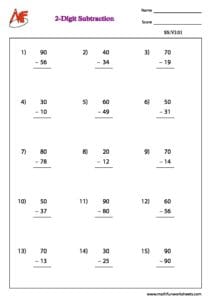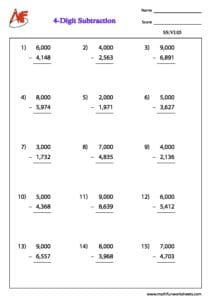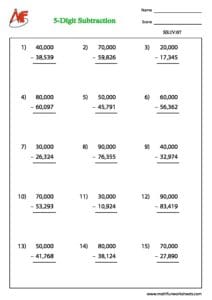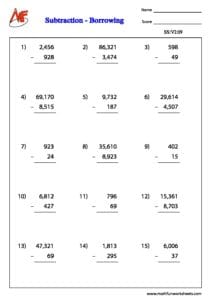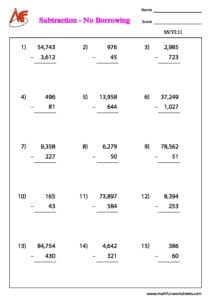- Home
- Numbers & Operations
- Subtraction
- Subtraction – Problems Ending With Zero
Browse by Topics
- English Worksheets
- Kid's Corner
- Numbers & Operations
- Addition
- Subtraction
- Multiplication
- Division
- Decimals
- Place Value
- Roman Numerals
- Skip Counting
- Odd & Even Numbers
- Patterns
- Cardinal & Ordinal Numbers
- Rounding Numbers
- Estimation of Numbers
- Estimation of Time & Money
- Counting & Cardinality
- Comparing Numbers
- Ordering Numbers
- Fractions
- Prime & Composite Numbers
- Squares & Cubes
- Divisibility Rules
- Factors & Multiples
- Data Handling
- Algebra
- Ratio
- Proportion
- Order of Operations
- Scientific Notation
- Exponents
- Algebraic Expressions
- Evaluating Algebraic Expressions
- Simplifying Algebraic Expressions
- Graphing Lines
- Point Slope Form
- Two Point Form
- Two Intercept Form
- Equations
- Identifying Functions
- Evaluating Functions
- Function Table
- Domain and Range
- Trigonometric Charts
- Quadrants
- Polynomials
- Measurement
- Geometry
- Word Problems
Subtraction – Problems Ending With Zero Worksheets
Subtraction – Problems Ending With Zero can seem tricky at first, especially for young learners. However, with the right approach, these problems become simple and manageable. When a number ends in zero, it usually means you’re working with round numbers like 10, 20, 100, or 500. These are easier to subtract because they follow clear patterns. Students just need to understand place value and basic subtraction facts.
For example, subtracting 50 from 90 is straightforward. You know that 90 minus 50 equals 40. The zeros in both numbers simplify the process. You subtract the tens and keep the zero at the end. This method works well for larger numbers too. If you subtract 200 from 500, the answer is 300. Again, you focus on the hundreds place and subtract as usual.
Transitioning to more complex problems, like 340 minus 120, still follows the same rule. Break the numbers into parts. Subtract the hundreds first, then the tens. Keep track of the place values. This helps avoid confusion and mistakes. Teaching students to line up numbers properly also makes subtraction easier.
Related Worksheets: Subtraction Activities, Picture Subtraction, Subtraction Tables
Subtraction Worksheets
Moreover, visual aids such as number lines or base-ten blocks can support learning. These tools help children understand how subtraction works with zeros. Practice is also key. Repeating similar problems helps students recognize patterns and build confidence.
In conclusion, subtraction problems that end in zero are an important step in building strong math foundations. They teach students to focus on place value and basic operations. With practice and the right techniques, anyone can master these problems. Encourage consistent learning, and soon subtraction with zeros will feel easy and natural.


